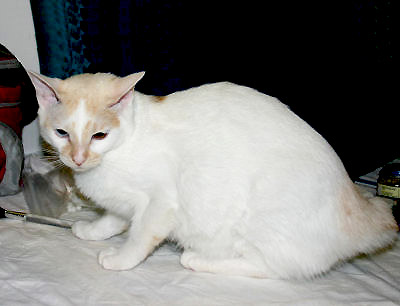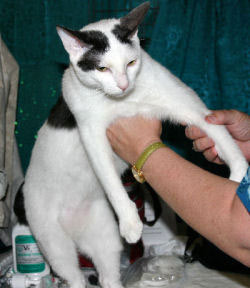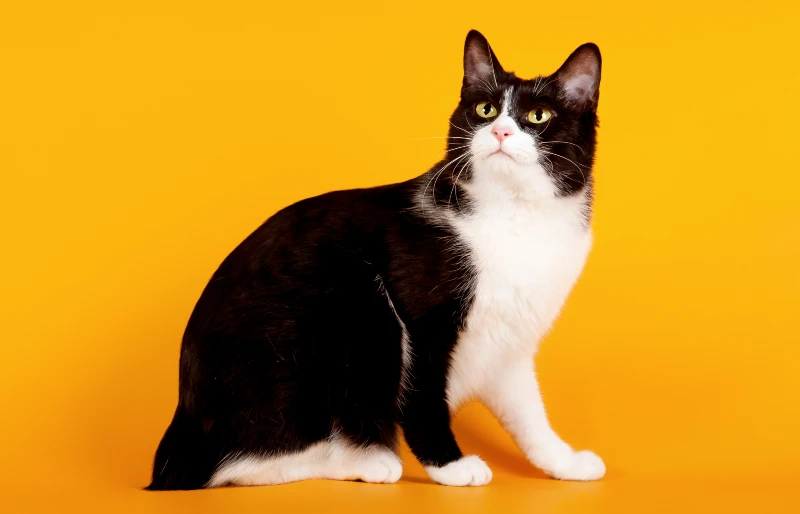
A Japanese Bobtail is a sweet and pretty cat breed… that could bring you good luck!
Japanese Bobtail cats are a well-known and respected cat breed in Japan. When possessing the favored Mi-Ke cat color pattern, the traditional three colors of black, red, and white, they are known as a Japanese symbol of good luck and happiness. It is thought that this cat breed may have originated in China, or possibly Korea, as long ago as the eighth century and then introduced to Japan. Today it is well represented in the United States and in several parts of Europe.
This breed is a medium sized slender, though muscular cat, with a triangular head and long legs. The main defining characteristic of the Japanese Bobtail is, of course, its 2 – 4″ (5-10 cm) tail that is often curved or kinked. The tail is fluffy and thicker than its body fur which gives the Bobs a pom-pom type appearance. The fur on its coat is of medium length, unless it is a Long-haired Japanese Bobtail. Yet this breed requires little grooming, a weekly brushing works fine. It has a small, harmonious voice. It enjoys talking with its owners in soft, melodious tones that some characterize as “singing”.
Japanese Bobtails are especially affectionate cats that enjoy living with families. They are playful and good with children. Socializing with other cats can be variable. Some say that this breed enjoys having other cat companions, while others say that it does not get along with other cats. This cat breed generally ignores dogs, but is likely to be interested in other small pets since it is a good mouser. Some have also been known for enjoying the water.
For information about keeping a pet cat, see:
Cat Care: How to Take Care of a Cat
- Kingdom: Animalia
- Phylum: Chordata
- Class: Mammalia
- Order: Carnivora
- Family: Felidae
- Genus: Felis
- Species: domesticus
Background
It is uncertain where Japanese Bobtail Cats originated from. Though there is a theory that they originated in China, it is most well-known for coming from Japan (hence the name Japanese Bobtail). This breed is popular in the United States and is represented in Europe, but is rare in France.
The Japanese Bobtail is a well-known breed in Japan, representing good luck and happiness when found with the favored Mi-Ke color pattern, consisting of a white coat with patches of black and red. However, its origin goes farther back than it’s presence in Japan. This breed is believed to have been brought to Japan from China, or possibly Korea somewhere between the sixth and tenth centuries. It is possible that the Japanese Emperor Ichijo requested the cat, since he was known as a cat enthusiast. Historical writings have also cited the Japanese Bobtail, or a very similar cousin, in the Far East, including Malaysia, Burma, and Thailand.
In 1968, Judy Crawford, an American living in Japan, sent two of her Japanese Bobtails to Elizabeth Freret, a breeder in the United States. The pair consisted of a tortoiseshell and white female named Madame Butterfly, and a red and white male named Richard. The pair produced kittens, which were shown in an American Cat show in 1969. The breed continued to gain popularity in the United States when Judy Crawford returned to America with her 38 Japanese Bobtails.
The breed was fully recognized in America by 1978. The Japanese Bobtail was introduced to England in the 1970’s and to France in 1981. Common names for this natural breed cat are Japanese Bobtail, Mi-Ke Cat (pronounced mee-kay and meaning “three colors”), Bobs, JBTs, Japanese Stompstaartkat (Holland). The Japanese Bobtail is also found in a long-haired variation, which has existed for centuries. Though this breed superficially looks similar to the Manx, they are not related.
Description
The Japanese Bobtail is a natural breed cat. Its main defining characteristic is its tail. The tail is 5-10 cm (2-4 inches) long and is curved, angled, or kinked. It can be flexible or rigid. The fur covering the tail is fluffy and thicker than the fur on the rest of the body, creating a “pom-pom” appearance.
The body of the Japanese Bobtail is medium-sized, lean, and muscular. The legs are slender, with the hind legs being longer than the front legs. The paws are long, thin, and oval. The head forms a nearly perfect equilateral triangle. The ears are large, wide-set, and at right angles to the head. The eyes are oval shaped and wide-set as well, and the nose is long. This breed is one of the lighter breeds, weighing 6-9 pounds. The average lifespan is 9-15 years.
 Japanese Bobtail Cat, Black and White Photo © Animal-World: Courtesy Justin Brough
Japanese Bobtail Cat, Black and White Photo © Animal-World: Courtesy Justin BroughThe coat is medium-length, or long in length for the Long-haired Japanese Bobtail. All color forms are acceptable except the Siamese and Abyssinian colors. However the favored color types include the following: black, red, and white (Mi-Ke); black, red, and cream (tortoiseshell); black and white, red and white, tortoiseshell and white; white; black; red.
Care and Feeding
The Japanese Bobtail has no specific dietary needs, but it is known for preferring fish over other food types.
Housing Your Cat
This is an adaptable cat breed that enjoys being indoors and outdoors. It is known for its hunting abilities, so it is likely to enjoy time outside. However it is not a breed that requires time outside. It is likely to be perfectly happy inside as well especially with lots of toys!
Maintenance
The Japanese Bobtail requires little grooming. Weekly brushing is advised.
Social Behaviors
This breed enjoys being around all types of people. It is good with children and develops strong relationships with the whole family. Some say it enjoys having cat companions, while others say it can be unfriendly with other cats. This trait is probably best observed on an individual basis. It is known for being disinterested in dogs, but may be very interested in any small animals it finds, since it is known as a good hunter and a mouser.
Activities
This is an active breed that enjoys playing. It should be provided with toys and play time with its owner. It can enjoy exercise indoors or outdoors.
Breeding/Reproduction
A Japanese Bobtail litter usually consists of three or four kittens. The kittens are quite large compared to other newborns, which may be the reason why they begin walking sooner than other breeds.
Common Health Problems
The only health problem prevalent in this breed is its sensitive, easily injured tail. Other than that health risk, they are generally healthy cats. In fact, they are known to have a high disease resistance.
Availability
Japanese Bobtail Cats are readily available from breeders that can be found on the internet or locally. Prices range from approximately $250-$1100. Breeders take into account the cat’s age, show quality, coat color, eye color, and gender when deciding a price. For instance, an adult pet-quality cat may be $250, while a female show-quality kitten with blue eyes may be $1100.
References
Featured Image Credit: dien, Shutterstock
